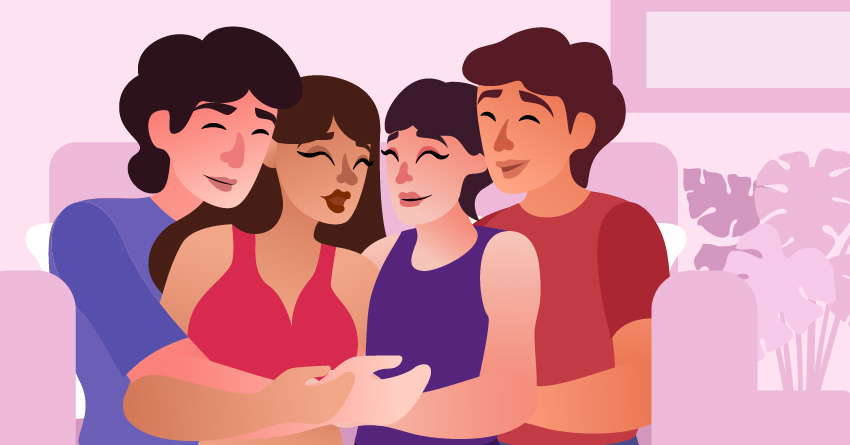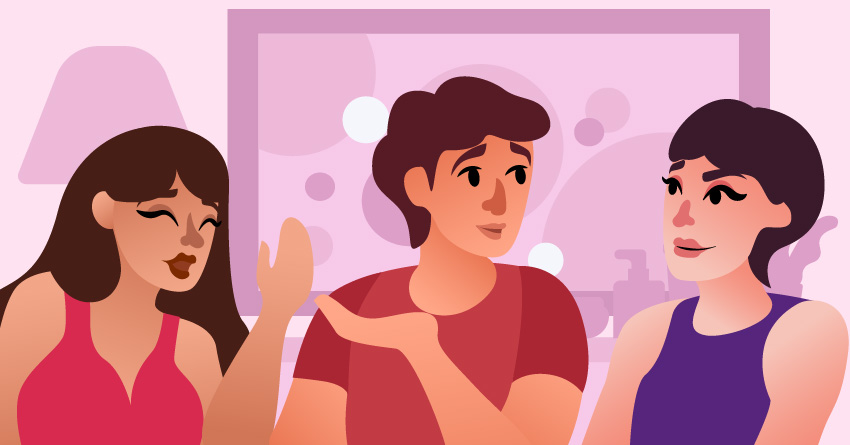
Do you ever wonder what it means to be in a polyamorous relationship? Do you find yourself having a romantic interest in two or more people or thinking of getting into polyamorous dating? Don’t worry, because you’re not alone. If you’re curious about polyamory, you’ve come to the right place.
Polyamory has become an umbrella term for various forms of non-monogamous, multi-partner relationships, or non-exclusive sexual or romantic relationships. In this article, we will list the nuances and types of polyamorous relationships. There is no specific agenda with this article other than to raise awareness on a topic that is hard to discuss.
What Is a Polyamorous Relationship?

A polyamorous relationship is a type of non-monogamous relationship that differs from other relationships in that multiple people are involved – not just two. For some people, a polyamorous relationship involves being in a relationship with multiple people but having one main partner.
For some, a polyamorous relationship involves being in a relationship with multiple people but having one main partner. And for others, polyamory is the possibility of being in two completely different relationships simultaneously. To put it simply, the fundamental philosophy of polyamory is that sexual love shouldn’t be confined to the strictures of monogamy but expressed fully and freely.
20 Things To Know About Polyamorous Relationships
There are a lot of things to consider if you would want to explore polyamory. Start your informed journey on polyamory by reading the key points below.
1It isn’t the same as open relationships.

According to the Handbook of the Sociology of Sexualities, an open relationship is typically defined as having sexual intercourse with others but that those sexual encounters don’t develop into relationships. Meanwhile, polyamory involves having multiple relationships. Love and emotional connections are the driving forces in the latter.
2It’s not all about sex.

To expound on the previous point, an open relationship allows its partners to pursue nonserious sexual and romantic relationships with people outside the relationship. However, open relationships share monogamous relationships the obligation not to pursue any serious romantic relationships with other people.
By contrast, polyamorous people often — though not always — start seeing different people pursue a meaningful romantic relationship with them. Sex can be part of the deal, but it is not usually the focus. The idea is that parties involved are all open and honest and that they follow a moral code that they agreed on within their relationship.
3It is not a disorder.

It is an alternate way of life. Polyamory is neither a mental illness nor a personality disorder. A study was conducted with around 1,093 polyamorous individuals measuring the various criteria like needing fulfillment and relationship satisfaction. And also including commitment for two ongoing romantic relationships.
4It’s okay to experiment with polyamory.

There are ways to test out polyamory either as a single person or as a couple in respectful ways to understand if it is right for you. So long as you are not fetishizing polyamory, feel free to experiment to see if it is the right relationship style for you. It can be quite difficult to know if you are cut out for these relationships if you have never experienced them before. Know that it is okay to experiment with polyamory and find out whether you are cut out for it or not.
5There are many different ways to be non-monogamous.

There are plenty of ways to practice non-monogamy. For instance, there are solo-polyamorists who foster connections with people and focus on strengthening them. A solo poly-amorist may have two lovers simultaneously. But also, there are people in their lives that they consider their family of choice, as a former spouse.
There are also polyaffective families, a term coined by Eli Sheff, an academic expert on polyamory. This entails the idea of maintaining a relationship outside of intimate relationships with everyone else you’re connected to. One partner in a polyamorous relationship may also identify as monogamous, and those are called poly-mono relationships. According to experts, there isn’t any hard data on how successful this tends to be. However, there are some rather robust online communities of poly-mono people who are happy.
6Polyamory is one form of consensual non-monogamy.

You may picture a romantic relationship as two people committed exclusively to one another —known as monogamy. Consensual non-monogamy, on the other hand, involves relationships with more than one person, with the consent of everyone involved. Polyamory is just one of the ways to practice consensual non-monogamy. You may have also heard of other forms, like swinging or open relationships.
7There are several terms related to polyamory that are worth knowing such as primary, triad, quad and much more.

If you are new to polyamory, here are some of the terms to help you understand it more:
Primary
The primary partner is a “main squeeze” in a polyamorous relationship with a hierarchical structure. Not every polyamorous relationship has a “primary.” If you do, your primary might be the person you live with, have kids with, or are married to.
Secondary
A secondary partner has a more casual relationship than the primary. You might be fully committed to your secondary partner, but your lives are less entwined through elements like finances or housing.
Triad
A triad, also referred to recently as a “throuple”, is a relationship between three people. It might look like one person dating two different people or all three dating one another.
Solo polyamorous
Solo polyamory means you’re not interested in becoming part of a couple or any other relationship that includes entanglements, such as sharing finances, housing, or marriage. For example, you might be the secondary partner to several people but prefer not to have a primary partner.
Quad
A quad is a relationship between four people. A common example is when two polyamorous couples meet, and each person begins dating one person from the other couple.
Full quad
A full quad consists of four people, with each romantically or sexually involved with every other member.
Paramour
A paramour is an outside member of a marriage. For example, the girlfriend of a husband in a polyamorous marriage.
8There are physical boundaries in polyamorous relationships.

Like all relationships, there are physical boundaries to consider when you’re in a polyamorous relationship. This includes the following:
Limits in sexual acts and what you’re willing to explore
How do you feel about different types of sex, like oral sex, anal sex, one-time sex with a stranger, or BDSM? Are there sex acts that you’d rather keep between you and your partner? Is sex with other people okay only with barriers like condoms? Maybe you’re fine with sex itself, but kissing feels more like something that only you and your partner share. Or you might be okay with your partner cuddling in private but not holding hands with someone else in public places.
Sharing space with your partner’s partner(s)
In terms of polyamorous relationships, sharing a private space depends on the people involved. Do you mind being in the same place at the same time as your partner’s other partners? Are you okay with living in the same space as long as you don’t have to witness displays of affection between them? Or how do you feel about going on three-way or four-way dates?
9There are emotional boundaries to consider too.

Minding the different boundaries will help you set the grounds for the relationship. Here are some examples of emotional boundaries to consider:
The details you share
Are you curious to know the details if your partner has sex, just the fact that your partner had sex, or not hear about the sex at all? How would you feel if your partner introduced another partner to their family, to your kids, or the public via social media? Or how much would you like to tell your partner about your dating life or hear about theirs?
Setting the boundary between serious and casual relationships
How would you feel if your partner said “I love you” to another person or called another person their boyfriend, girlfriend, or partner? Are you okay with your partner building a deep, long-term relationship with someone else or would you prefer if they keep things casual?
10Overall, there should be ground rules between people in polyamorous relationships.

When you finally decide to delve into polyamory, you must lay the specific ground rules between you and your partners. These tips will guide you in making your ground rules informative and enjoyable:
Make a “Yes, No, Maybe” list that can be a useful tool in establishing each of your likes and dislikes. For example, you might say yes to bringing other partners home to visit, no to having overnight guests, and maybe to staying overnight at another partner’s home.
Schedule times for checking in with each other. So you set ground rules initially. But that doesn’t mean those rules have to be set in stone. It’s best to keep talking about your relationship parameters to make sure they’re still working out and change things up if necessary. So if you’re trying polyamory for the first time, it might be fun to plan regular check-ins to share how it’s going for you.
12Polyamory is not the same as polygamy.

Polygamy is almost universally heterosexual, and only one person has multiple spouses of a different gender. Polyamory allows any individual with any gender or sexual orientation to be in consenting relationships with more than one person, concurrently. Though the concept has been around for centuries, polyamory has come further into the forefront of people’s consciousness in recent years. From TV shows like House of Cards to celebrities admitting that they’re in open relationships, polyamory is very much in the cultural ether.
13There are four main types of polyamory.

To look further into polyamory, here are its four major types:
Primary partner + others approach
You are in one main relationship, and you have other connections beyond that central relationship. For example, Jen and Olivia are a couple, and they live with each other, but Olivia is also dating Chiara for 3 years. Olivia and Chiara love and see each other every few weeks, but their bond doesn’t extend to doing primary couple things.
Group approach
You may be engaged in a relationship with multiple people in the same relationship. For instance, Jen, Olivia, and Chiara are in one relationship. So in this example, there are four relationships: each person’s relations with each individual, plus the group dynamic.
Egalitarian network approach
Not one relationship is the main relationship in a person’s life. This doesn’t mean that the relationships don’t reach a level of commitment. It’s just that nothing is considered the “main one.”
Using the names we used earlier as examples, Jen and Olivia are in a long-term relationship. Olivia is also in a long-term relationship with Chiara. Chiara may also have a long-term relationship with other individuals and so on. The levels of intimacy in each relationship depends, of course, on the people involved.
Solo approach
People who use the solo approach come at it from an angle of never coupling up so they don’t couple up with one central relationship. People who practice the solo approach are in relationships, but they maintain the identity of a solo individual. That may mean they identify as single but are in multiple relationships. They talk about their lives more centered on the individual rather than talking about couplehood or family.
Please note that this is a more generalized view of the types of polyamory, and elements in each type may overlap in different relationships.
15It all boils down to three major values.

While polyamorous relationships are unique, people in healthy polyamorous relationships share many similar values, such as:
Good communication
While the common notion about polyamory is all about sex. Some polyamorous people say that it’s more about being open about your feelings than anything else. In essence, open and honest communication is key for maintaining multiple relationships in a healthy way.
Consent
You can’t have consensual non-monogamy without consent. Moreover, taking on new partners or engaging in new sexual relationships and commitments all require consent for everyone involved.
Trust
Polyamorous people, just like monogamous couples, need to be able to trust one another. Similarly, polyamorous people may build trust that includes communicating about new partners, practicing safe sex, and keeping promises.
15It doesn’t mean you’re uninterested in commitment.

People aren’t polyamorous because they’re unhappy about committing to a relationship. One research study stated no difference in relationship satisfaction between people who are monogamous or consensually non-monogamous.
Commitment for monogamous people can mean expressing love by putting time, trust, and respect for shared agreements into a relationship with another person. So, commitment for polyamorous relationships could mean the same, just with a different set of agreements.
16Being polyamorous doesn’t make you more enlightened.

If you believe you are more wise or are better from other by being polyamorous, you may end up behaving carelessly. And in this matter, don’t assume monogamy is better either. Your relationship model doesn’t make you any better than anyone else. And your relationship model doesn’t discharge your need to treat people around you well.
17Polyamory won’t fix existing problems in a toxic relationship.

There are instances when people believe that introducing polyamory into a failing relationship will solve their problems. But this is a completely unhealthy way to fix relationship issues. For instance, introducing more people to a toxic relationship can only worsen it. As mentioned in prior points, make sure that you are considering polyamory for the right reasons.
18Don’t consider polyamory for the wrong reasons.

Polyamory is not a way to not be faithful to a partner. Even in polyamory, you have to maintain respect and trust with your partners. When beginning in polyamory, take the time to reflect on what aspects of it appeal to you and evaluate if it aligns with your principles.
19Parties should bring up what they need and can give in the relationship.

When entering a polyamorous relationship, people involved should always state their limits and what they need in a relationship. For example, do you need to be with someone who expresses words of affirmation as their love gesture? Or is it to be with that great person and spend a huge portion of your time with them? So establishing what you need and can offer in a relationship is key to laying down the ground rules in a polyamorous relationship.
20The essence of polyamory is to spread the love by loving others.

To love someone and feel real enjoyment when you find love with another is a fantastic feeling. These relationships are no less psychologically healthy or happy than traditional monogamous ones and may positively affect the people involved in them.
Frequently Asked Questions

We’ve already laid the terms and things to know about polyamory, there will always be questions that will arise, and that’s okay. So to further help you, our dear readers, we’ve listed an FAQ as well down below.
1How is polyamory different from polygamy?
Polyamory is the act of having intimate relationships with more than one person at the same time. A polyamorous person might have or might be open to having multiple romantic partners. Polygamy, on the other hand, involves being married to multiple partners.
2Does polyamory mean involving in group sex?
If having frequent threesomes sounds exhausting to you, then you should know that plenty of polyamorous people would agree with you. While polyamory can include sexual relationships with more than one person, it’s not about having sex with multiple people simultaneously.
3Can a woman have multiple husbands?
A woman having many husbands is allowed in some states, such as South Africa, through polyandry. This entirely depends on which country and culture you are in of course. Polyandry is a form of polygamy in which a woman takes two or more husbands simultaneously. For example, fraternal polyandry is practiced among Tibetans in Nepal, parts of China, and northern India. And in this instance, two or more brothers are married to the same wife, with the wife having equal “sexual access” to them.
4What is a female polygamist called?
A female polygamist is called a polyandrist. Polyandry is contrasted with polygyny, involving one male and two or more females. And the two best-known areas in which polyandry was studied and continued to be practiced into the 21st century are the Plateau of Tibet (a region shared by India, Nepal, and the Tibet Autonomous Region of China).
5How do I talk about polyamory with my current partner?
Introduce the idea to your partner in a nonthreatening way. And before trying to date anyone, spend some time talking about the concept of polyamory with your partner. Another one way to start the conversation is by talking about how you are already open to other relationships.
6What is cheating in a polyamorous relationship?
A polyamorous person can cheat on their partners by completely ignoring agreed-upon boundaries about dating others, like not telling their partners when they have sex with new people.
7How do I navigate the transition to being polyamorous?
When starting with polyamory, it helps to research it and evaluate your intentions on whether or not it is good for you. You could also ask polyamorous people that you know about their reasons for making the shift. Then evaluate if your principles, beliefs, and lifestyle could fit being in a polyamorous relationship.
8Who enters into a polyamorous relationship?
Anyone can become involved in a polyamorous relationship as long as knowing what doing so entails is understood. While polyamorous people tend to be more open, it does not mean that they are automatically involved in sex with multiple people or that their sexual preferences are fluid.
9How does it work?
Polyamorous relationships differ from typical monogamous relationships in which multiple people are involved, not just two. Moreover, polyamorous relationships depend on the ground rules between people involved and maintaining healthy relationships based on trust, good communication, and consent.
10How is polyamory different from an open relationship?
The essence of polyamory is to have multiple relationships as love and emotional connections are the driving forces. Polyamory is not completely about sex, while open relationships mean having outside sexual relationships that do not form into relationships.
Takeaway
Overall, in various forms of relationships, it’s important to set your limits and being clear on your true intentions. As long as all parties are open, honest, and safe, there’s no reason why a polyamorous relationship can’t work. And with all this information on hand, you are certainly off to a great start on an informed journey into polyamorous relationships.
-
₱3,399.00
-
₱5,000.00
-
₱4,745.00
-
₱3,400.00














